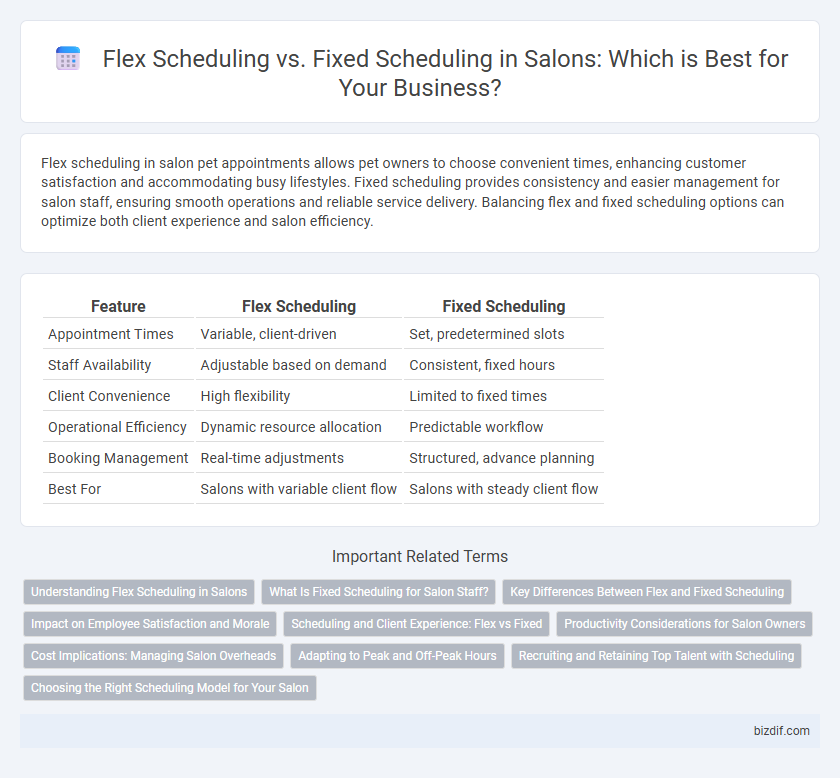Flex scheduling in salon pet appointments allows pet owners to choose convenient times, enhancing customer satisfaction and accommodating busy lifestyles. Fixed scheduling provides consistency and easier management for salon staff, ensuring smooth operations and reliable service delivery. Balancing flex and fixed scheduling options can optimize both client experience and salon efficiency.
Table of Comparison
| Feature | Flex Scheduling | Fixed Scheduling |
|---|---|---|
| Appointment Times | Variable, client-driven | Set, predetermined slots |
| Staff Availability | Adjustable based on demand | Consistent, fixed hours |
| Client Convenience | High flexibility | Limited to fixed times |
| Operational Efficiency | Dynamic resource allocation | Predictable workflow |
| Booking Management | Real-time adjustments | Structured, advance planning |
| Best For | Salons with variable client flow | Salons with steady client flow |
Understanding Flex Scheduling in Salons
Flex scheduling in salons allows stylists to choose their working hours based on client demand and personal preferences, enhancing work-life balance and reducing burnout. This approach maximizes operational efficiency by aligning staff availability with peak appointment times, improving customer satisfaction through better service coverage. Unlike fixed scheduling, flex scheduling adapts to fluctuating trends and seasonal variations, fostering a dynamic and responsive salon environment.
What Is Fixed Scheduling for Salon Staff?
Fixed scheduling for salon staff involves setting predetermined work hours and shifts that remain consistent week-to-week, providing stability and predictability for employees. This method allows salon managers to plan resources efficiently, ensuring that peak business hours are adequately staffed to meet client demand. Staff members benefit from a reliable routine, which enhances work-life balance and reduces scheduling conflicts.
Key Differences Between Flex and Fixed Scheduling
Flex scheduling in salons offers employees variable work hours based on demand, enhancing work-life balance and accommodating client flow fluctuations. Fixed scheduling involves predetermined, consistent shifts that provide stability and routine but may limit flexibility in handling peak appointment times. The key differences lie in adaptability to client needs and employee preferences, with flex scheduling promoting agility and fixed scheduling emphasizing predictability.
Impact on Employee Satisfaction and Morale
Flex scheduling in salons significantly enhances employee satisfaction by offering staff the autonomy to choose work hours that align with their personal lives, leading to improved morale and reduced burnout. Fixed scheduling, while providing consistency, often limits flexibility, which can result in decreased motivation and higher turnover rates. Studies indicate salons adopting flex schedules report a 20% increase in employee retention and higher overall productivity due to positive work-life balance.
Scheduling and Client Experience: Flex vs Fixed
Flex scheduling offers salons the advantage of accommodating clients' varying availability, leading to improved customer satisfaction and higher retention rates compared to fixed scheduling. Salons implementing flex scheduling can better manage appointment gaps and reduce no-shows by allowing clients to choose preferred times outside traditional hours. Fixed scheduling provides consistency and predictable workflow for staff but may limit client options, potentially impacting overall experience negatively in a competitive market.
Productivity Considerations for Salon Owners
Flex scheduling in salons increases productivity by allowing staff to work during peak hours based on client demand, reducing idle time and optimizing labor costs. Fixed scheduling offers consistent employee availability but may lead to underutilized hours during slow periods and decreased overall efficiency. Balancing client appointments with staff availability through flex scheduling enhances salon throughput and maximizes revenue potential.
Cost Implications: Managing Salon Overheads
Flex scheduling in salons reduces labor costs by aligning staff hours with fluctuating client demand, minimizing idle time and overtime expenses. Fixed scheduling often leads to higher overheads due to consistent payroll regardless of customer volume, increasing wage inefficiency during slow periods. Optimizing schedules with software tools helps balance employee availability and client appointments, significantly lowering operational costs and improving profitability.
Adapting to Peak and Off-Peak Hours
Flex scheduling in salons enables staff to adjust their working hours based on peak customer demand, improving service efficiency during busy periods like weekends and evenings. Fixed scheduling maintains consistent shift times, providing stability but potentially leading to under- or over-staffing during off-peak hours. Adapting to peak and off-peak fluctuations with flexible schedules enhances client satisfaction and optimizes labor costs.
Recruiting and Retaining Top Talent with Scheduling
Flex scheduling offers salons the advantage of attracting top talent by accommodating individual stylist preferences and work-life balance, leading to increased job satisfaction. Fixed scheduling provides consistency and predictability, appealing to professionals who value routine and stability in their work hours. Balancing these scheduling approaches helps salons recruit and retain skilled stylists while enhancing overall team productivity and client satisfaction.
Choosing the Right Scheduling Model for Your Salon
Choosing the right scheduling model for your salon hinges on balancing flexibility and consistency to enhance client satisfaction and staff productivity. Flex scheduling allows stylists to manage their hours based on demand, promoting work-life balance and reducing burnout. Fixed scheduling ensures predictable operational hours and consistent client appointments, essential for maintaining steady salon revenue and service quality.
Flex Scheduling vs Fixed Scheduling Infographic

 bizdif.com
bizdif.com